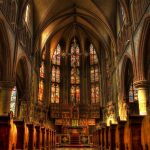
See, I have chosen Bezalel son of Uri, the son of Hur, of the tribe of Judah, and I have filled him with the Spirit of God, with wisdom, with understanding, with knowledge and with all kinds of skills … Moreover, I have appointed Oholiab son of Ahisamak, of the tribe of Dan, to help him. Also I have given ability to all the skilled workers to make everything I have commanded you… – Exodus 31:2-6
So Christ himself gave the apostles, the prophets, the evangelists, the pastors and teachers, to equip his people for works of service, so that the body of Christ may be built up until we all reach unity in the faith and in the knowledge of the Son of God and become mature, attaining to the whole measure of the fullness of Christ. – Ephesians 4:11-13
What exactly does it mean to be a pastor? In my experience, two images dominate the conversation, one scriptural and the other cultural. Scripturally, 1 Peter 5 speaks of church elders shepherding the flock of God among them. This shepherding imagery is deeply intertwined with the pastoral vocation. Indeed, the very term “pastor” is an agrarian term that refers to the care of sheep and cattle. Culturally, the image of the pastor as entrepreneur has come to the fore. In this scheme, the pastor is like a business person who hustles to make their church grow. Shepherd as caretaker or entrepreneur as evangelistic hustler. Both images can be instructive, but both also fall short when it comes to the purposeful shaping of the Christian community. For this we need another image: the pastor as artisan or builder.
Importantly, the image of the pastor as builder or artisan is not a clever innovation. Rather, the imagery is rooted in the Apostle Paul’s first letter to the Corinthians. In chapters 1-3 of that correspondence, Paul employs farming and building imagery to combat the Corinthians’ tendency to exalt some ministers over others. The idea here is that different ministers serve different purposes in congregational life. By employing farm imagery, Paul shows that he and Apollos are coworkers rather than competitors. Paul planted seed that Apollos later watered and helped grow. Paul’s building imagery is similar but leans in a different direction. Rather than focusing on the complementary work of different ministers, Paul focuses here on judgment by painting himself as a master builder who has laid a foundation. He has done good work, and another minister is now adding to it. This new minister better mind his p’s and q’s! Here’s how Paul himself puts it. The passage is a bit long but worth quoting in its entirety.
By the grace God has given me, I laid a foundation as a wise builder, and someone else is building on it. But each one should build with care. For no one can lay any foundation other than the one already laid, which is Jesus Christ. If anyone builds on this foundation using gold, silver, costly stones, wood, hay or straw, their work will be shown for what it is, because the Day will bring it to light. It will be revealed with fire, and the fire will test the quality of each person’s work. If what has been built survives, the builder will receive a reward. If it is burned up, the builder will suffer loss but yet will be saved—even though only as one escaping through the flames.
Don’t you know that you yourselves are God’s temple and that God’s Spirit dwells in your midst? If anyone destroys God’s temple, God will destroy that person; for God’s temple is sacred, and you together are that temple. – 1 Corinthians 3:10-17
As that last section makes clear, Paul grounds his imagery of pastor as builder in a common New Testament picture: the church as the temple of God. Most often when this imagery is employed, God himself seems to be the implicit builder of his temple (see Ephesians 2:19-22; 1 Peter 2:4-5). Here in 1 Corinthians, however, we see that ministers also have a hand in how God’s temple takes shape. Unsurprisingly, this insight is congruent with the wider story of scripture.
According to Exodus 26-31, God took great care in the construction of the tabernacle – the structure that preceded the temple as the seat of God’s presence among his people. The bulk of those chapters are dedicated to detailed instructions for how the elements of the tabernacle should be made. Then, in chapter 31, God tells Moses that he has set apart and empowered an artistic community to take his instructions from page to reality. There it is: God himself is the source of the structure’s parameters – something of a master artist – but he employs people in the actual construction.
When it comes to viewing the church community as a temple, we see a similar dynamic at play. God himself is the master builder who sets the pattern and adds to the building through conversion. There is also a human element, though. According to Ephesians 4:11-13, Christ has gifted apostles, prophets, pastor-teachers, and evangelists to the church for its growth toward maturity. In the immediate context, Paul is using body imagery as he names these various servants of the church. Regardless of the particular imagery at play, though, we find in this passage that God has set apart and empowered a select group of people to shape his church. That sounds a lot like the artisans who constructed the tabernacle. Moreover, it fits well with Paul’s discussion of builders in 1 Corinthians 3. The particular servants mentioned in Ephesians 4 are those with the special responsibility of shaping the house of God.
We live in a moment when the western church is being formed by a multitude of voices. Some of these voices are built into the grain of western living like shopping or sporting events. James K A Smith calls these cultural liturgies that shape our perception of reality. Other voices are more obvious but still subtle like the commercials and TV shows that inundate us with images of the good life. Then there are the voices that blatantly seek to shape our understanding of reality. Think here of 24 hour news pundits who actually narrate the meaning of current events. While these narratives are sometimes congruous with the kingdom, they often result in God’s temple being shaped in non-gospel directions that range from slightly off center to downright ugly. In so many of these cases, the church, the dwelling place of God, which is meant to be beautiful and holy, becomes less worthy of God’s presence.
Enter now the special community whom God has called and empowered to shape his dwelling. Following 1 Corinthians 3, we can call them builders. Following Exodus 31, we can call them artisans. Either descriptor points to the active shaping of God’s people into a worthy dwelling place. For my part, I think the vision of pastors as artisans is helpful because of its artistic overtones. In a world that shapes the church to mirror its ugliness, we need skilled craftspeople to step forth for beautiful counterformation. Their goal is to make God’s temple into the beautiful dwelling he desires. They are called and gifted for this very purpose. And, they are accountable to God for the work they produce. We need these kinds of pastors now more than ever. By God’s grace, they capture our imaginations for the kingdom and craft with care God-honoring systems of communal life. These are the pastors who will shape the faithful church of the future. By his grace and gifting, they are artisans in the house of God.




